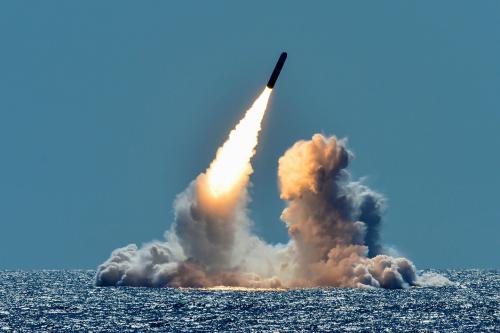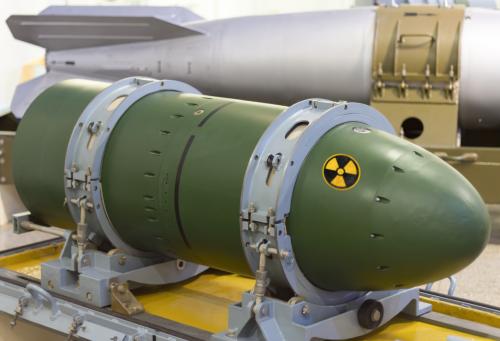In the nearly six decades since the advent of nuclear arms control, virtually all negotiated agreements to limit stockpiles of nuclear weapons have been concluded by the United States and the Soviet Union or Russia. That is logical, given that even today the U.S. and Russian arsenals are many times larger than those of other nuclear weapons states.
The United States continues to focus on bilateral nuclear reductions with Russia. However, in recent years, Russia has signaled its desire to include other nuclear weapons states—such as Britain, France, and China. Though it is unlikely that other states will agree to reduce or even cap their nuclear stockpiles without further reductions by the United States and Russia, it is useful to identify prospective entrants to the global arms control regime, as well as possible concrete means of pursing arms control on a multilateral basis.
In a recent Brookings paper, “Third-country nuclear forces and possible measures for multilateral arms control,” we examine three broad avenues for opening space for multilateral nuclear arms control: new arms control agreements, concrete transparency and confidence-building measures, and new multilateral channels for dialogue on the nuclear file.

New arms control agreements
The most straightforward means of advancing multilateral arms control would be a negotiated treaty limiting nuclear weapons, perhaps among the five nuclear weapons states recognized by the Treaty on the Non-Proliferation of Nuclear Weapons (NPT)—Britain, China, France, Russia, and the United States. However, it is exceedingly unlikely that the five states will agree to such a treaty in the near future, since the disparities between the states’ arsenals mean that such an agreement would almost certainly mandate different numerical limits, something very hard to negotiate. A more promising alternative would be for Russia and the United States to negotiate a follow-on agreement to the New Strategic Arms Reduction Treaty (New START) and ask Britain, France, and China to unilaterally commit to cap their warhead levels, as long as Russia and the United Sates remained in compliance with their treaty-mandated reductions.
Another option is a treaty banning or limiting a type of nuclear weapons delivery system, such as intermediate-range missiles. A multilateral treaty, based on the 1987 Intermediate-Range Nuclear Forces (INF) Treaty, could extend the ban on land-based intermediate-range nuclear missiles to China. Such a treaty could also incorporate Britain and France, which do not currently possess such missiles. But China is likely to balk at a measure which would require it to eliminate a class of delivery system. Alternatively, China and potentially other countries could agree to cap their INF missile numbers, while Russia and the United States remain at zero.
Transparency and confidence-building measures
If negotiated treaties prove too difficult to reach in the near term, the five countries might pursue transparency and confidence-building measures which would lay the groundwork for future negotiations. Possible measures might include: data exchanges, inspections and demonstrations, notifications, and de-mating and de-alerting nuclear forces.
Formal annual or biannual data exchanges on numbers and types of warheads and delivery systems would help reduce the potential for miscalculation regarding the size and purpose of the countries’ nuclear arsenals. A more ambitious exchange might provide more specific data, including locations of some systems, though China might balk at such a measure.
Joint inspections and demonstrations of the countries’ nuclear forces could also help prevent misunderstandings and yield valuable insights for a future negotiation. Russia and the United States could allow Britain, France, and China to observe some New START-mandated inspections, and the three could reciprocate with demonstrations of some of their nuclear systems.
Five-party notification of major strategic exercises and test launches of nuclear-related systems such as intercontinental ballistic missiles (ICBMs) and submarine-launched ballistic missiles (SLBMs) would also help build trust and enhance mutual understanding. The five countries might consider founding communications centers in Beijing, London, and Paris, which would serve the same purpose as nuclear risk reduction centers in Russia and the United States.
A more concrete measure might address the readiness of the countries’ nuclear weapons themselves. The five countries could unilaterally commit to de-mating nuclear warheads from delivery systems for some portion of their nuclear arsenals (e.g., non-strategic nuclear weapons). They might also agree to de-alert their nuclear forces, including ruling out launch-on-warning and launch-under-attack policies.
New channels for dialogue
As the five parties explore the feasibility of negotiated arms control agreements and transparency and confidence-building measures, they will need to address gaps in understanding of strategic concepts, as well as individual concerns regarding specific nuclear weapons and systems. To that end, the countries might agree to found new channels for dialogue on nuclear-related issues.
The first channel might focus on strategic concepts and emergent concerns. Regular, high-level meetings on strategic stability, employment doctrines for nuclear weapons, and new technologies could help reduce uncertainties and dispel misconceptions.
A second channel could focus on specific nuclear weapons systems and related technologies. The five parties might discuss a moratorium on production of new fissile material for nuclear weapons. Another potential subject for consideration in such a forum would be unilateral, non-legally-binding commitments to reduce or eliminate specific nuclear weapons or delivery systems. The five parties might also use a channel focused on extant systems as a venue for reiterating their commitment under the NPT to take steps towards eliminating nuclear arms.
It is unlikely that negotiated multilateral treaties to reduce nuclear weapons will be reached in the near future, particularly without a new bilateral arms reduction treaty between Russia and the United States. With a resumed nuclear dialogue between Washington and Moscow, small, incremental measures involving the next logical entrants to the global arms control regime—Britain, France, and China—may be achievable. This approach would have to begin with modest steps such as transparency and confidence-building measures. Such measures might not meet the high expectations of some states—particularly non-nuclear weapons states that have called for the swift elimination of all nuclear weapons. However, they could begin to make reductions to global nuclear stockpiles a collaborative, multilateral effort, and thereby reducing the risk of arms races and nuclear use.
The Brookings Institution is committed to quality, independence, and impact.
We are supported by a diverse array of funders. In line with our values and policies, each Brookings publication represents the sole views of its author(s).








Commentary
Nuclear arms control beyond the U.S. and Russia
August 29, 2016